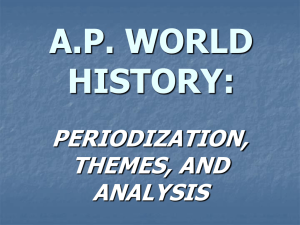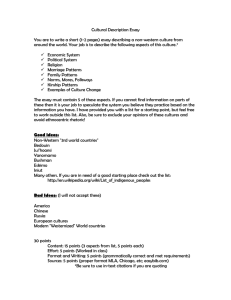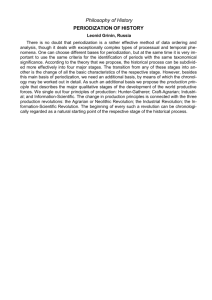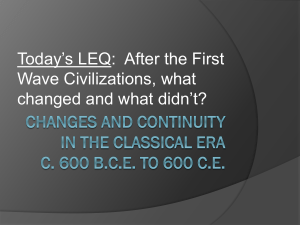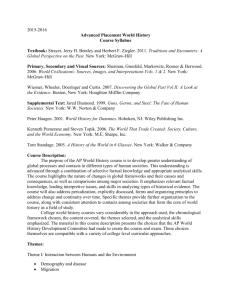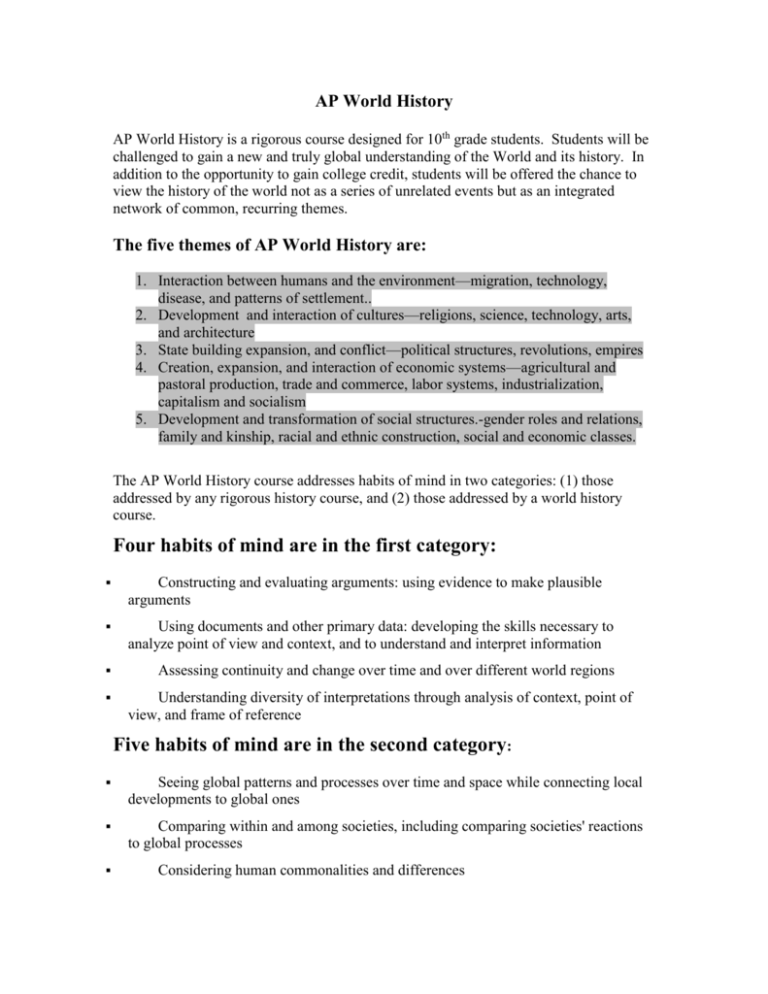
AP World History
AP World History is a rigorous course designed for 10th grade students. Students will be
challenged to gain a new and truly global understanding of the World and its history. In
addition to the opportunity to gain college credit, students will be offered the chance to
view the history of the world not as a series of unrelated events but as an integrated
network of common, recurring themes.
The five themes of AP World History are:
1. Interaction between humans and the environment—migration, technology,
disease, and patterns of settlement..
2. Development and interaction of cultures—religions, science, technology, arts,
and architecture
3. State building expansion, and conflict—political structures, revolutions, empires
4. Creation, expansion, and interaction of economic systems—agricultural and
pastoral production, trade and commerce, labor systems, industrialization,
capitalism and socialism
5. Development and transformation of social structures.-gender roles and relations,
family and kinship, racial and ethnic construction, social and economic classes.
The AP World History course addresses habits of mind in two categories: (1) those
addressed by any rigorous history course, and (2) those addressed by a world history
course.
Four habits of mind are in the first category:
Constructing and evaluating arguments: using evidence to make plausible
arguments
Using documents and other primary data: developing the skills necessary to
analyze point of view and context, and to understand and interpret information
Assessing continuity and change over time and over different world regions
Understanding diversity of interpretations through analysis of context, point of
view, and frame of reference
Five habits of mind are in the second category:
Seeing global patterns and processes over time and space while connecting local
developments to global ones
Comparing within and among societies, including comparing societies' reactions
to global processes
Considering human commonalities and differences
Exploring claims of universal standards in relation to culturally diverse ideas
Exploring the persistent relevance of world history to contemporary developments
Teaching Strategies and Student Expectations:
All material is presented and all assessments are given in terms of the 6 themes of
World History, the regions of the world, the 5 time periods of World History, and the 7
Habits of Mind. During lectures, class discussions, graded seminars, map and atlas work,
and other class and out-of-class activities, students are encouraged to identify which
theme or themes are relevant to the material, which time period they are working with,
what makes one time period different or similar to another one, and which region or
regions are being discussed or compared. The goal is that the 7 Habits of Mind will
quickly become true habits.
Students are expected to keep up with daily readings. Students will be quizzed
almost daily on the required readings.
Most class discussions and assignments will focus not on lists of historical facts and
data but on how these facts and data fit together into an amazing network of commonly
recurring themes. For example, knowing what the encomienda system was is only a
small part of the puzzle and is something each student should know simply from having
read about it. In class and through discussion and research, however, students will
explore how and where the encomienda system fits into World History as an example of
social structure, coercive labor, economic change, global interaction, etc.
Many classes, assignments, and assessments will focus on essay writing and
document analysis. The 4 major skills which students are expected to master are:
understanding/identifying point of view and bias in historical documents
the ability to draw comparisons between regions/societies based on
political,
economic, social, religious, geographic, and cultural differences and similarities
using evidence to support conclusions and arguments
understanding and analyzing the process of change
over time (as well as
analyzing continuity)
Many classes, assignments, and assessments will require students to work in small or
large groups to “do” history. Students will analyze documents or other historical
information and will use it to draw conclusions, form arguments, formulate thesis
statements, make comparative charts, create maps, or work with historical models or
templates (Conrad/Demarest, Crane Brinton, etc.)
Regular attendance is imperative and participation in study groups and after school
tutorials is highly recommended.
Last and most importantly, students are expected to communicate with the instructor
and with their peers about problems they are facing in understanding certain themes or
skills. A lack of understanding is no problem; not asking for help is.
Primary Text:
Upshur, Jiu-Hwa L, et al. World History. 4th ed. Comprehensive Edition. Belmont, CA
Wadsworth/Thomson Learning, 2002.
Primary Document Readers:
Stearns, Peter, et al. Documents in World History: Volume I: The Great Tradition: From
Ancient Times to 1500. 4th ed.
Stearns, Peter, et al. Documents in World History, Volume II: The Modern Centuries:
From 1500 to the Present. 4th ed.
Additional Classroom Texts and Resources:
Stearns, Peter, et al. World Civilizations: The Global Experience. 4th ed. AP Edition.
New York: Pearson Longman, 2005.
Bulliet, Richard W., et al. The Earth and its Peoples: A Global History. 3rd ed. Boston:
Houghton Mifflin, 2005.
Reilly, Kevin. Worlds of History: A Comparative Reader: Volume One: To 1550. 2nd ed.
Boston: Bedford/St.Martin’s, 2004
Reilly, Kevin. Worlds of History: A Comparative Reader: Volume Two: Since 1400.
2nd ed. Boston: Bedford/St.Martin’s, 2004
The Nystrom Atlas of World History. Chicago: Herff Jones, 2005.
Unit One: Foundations—c. 8000 BCE to c. 600 CE (5 weeks)
FOCUS QUESTIONS
1. What issues are involved in using “civilization” as the organizing principle of
World History?
2. How has religion helped hold societies together?
3. What systems of social and gender inequality developed during this time period?
4. How and to what extent did societies come into contact with one another during
this time period? What were the results?
5. What important traditions and institutions developed during this time period?
Unit One: Foundations—c. 8000 BCE to c. 600 CE
TOPICS & CONCEPTS
1. Pre-history and the nature of early human society (C1, C2, C4
1. Geography, climate and societal development
2. Population changes and causes
3. Social/gender stratification
4. Characteristics/differentiation of Foraging, Pastoral, and Agricultural
Societies
5. Effects of the emergence of agriculture on people and the environment
6. Understanding periodization: c. 8000 BCE to c.3500 BCE
2. Early Civilizations
Characteristics of “civilization” and the problems associated with using the
word “civilization.”
Impact of metal technology
Social/gender stratification in civilized societies
Political, social, religious, and economic structures of the 6 major early
civilizations: Sumerian, Egyptian, Indus Valley, Shang, Mesoamerican and
Andean civilizations.
Environmental and geographical issues related to the development of the 6
major early civilizations: Sumerian, Egyptian, Indus Valley, Shang,
Mesoamerican and Andean civilizations including environmental degradation.
Understanding periodization to 476 CE
3. Classical Civilizations
Transition from “early” to “classical” civilization
Political, artistic, and scientific contributions and institutions of major classical
civilizations: India, China, and the Mediterranean
Compare social and gender systems
4. Major Belief Systems
Basic features of major pre-Islamic belief systems: Polytheism, Hinduism,
Judaism, Confucianism, Daoism, Buddhism, and Christianity.
Religion and societal cohesion
Religion and gender
5. Late Classical period
Comparative collapse of empire: Han China, Gupta India, Western Roman
Empire
Migration and its effects: Huns, Germans, Bantu, Polynesian
Interregional trading systems by c. 600 CE and effects.
Understanding periodization to 600 CE.
Unit One:
LESSONS, ASSIGNMENTS & ASSESSMENTS
1.
2.
3.
4.
5.
6.
7.
Daily reading quizzes
DBQ exercise: shoe activity
Snapshot mapping: Early and Classical Civilizations
Unit Atlas activities
Conrad-Demarest Model on rise and fall of empires
Annotated timelines: periodization
Oral exam/Socratic Seminar: major comparisons, snapshots, and diverse
interpretations for this time period
8. Multiple choice exams (timed)
9. Essay exam: Compare and contrast the classical civilizations
10. Note-taking practice and instruction
11. Persian charts and other graphic organizers
12. Document analysis and Point of View exercise
Unit Two: The Post-Classical Period—c. 600 CE to c. 1450 CE (7 weeks)
FOCUS QUESTIONS
1. How and to what extent did Dar al-Islam serve as a unifying force?
2. What important migrations occurred during this time period and the last?
3. What was the nature and what were the results of the new contacts between
societies/religious groups during this time period?
4. What were the effects of Islam on women?
5. Compare and analyze the different political and social systems that developed
during this time period.
Unit Two: The Post-Classical Period—c. 600 CE to c. 1450 CE
TOPICS & CONCEPTS
1. The Islamic World
Origins, beliefs, and comparisons
Dar-al Islam as a unifying force
Islamic political structures
Splits within Islam
Islamic interactions with other religious/cultural groups
2. Interaction among societies
Missionary outreach of major religions
Sinicism in East Asia
Contacts between religious groups
New trade networks: Trans-Saharan, Indian Ocean/Swahili coast
Migration: Arab, Turk, Viking, Mongol, Aztec
3. East Asia
Chinese Reunification and the Tang/Song Recovery
Mongol invasion and Empire building
4. Europe
Political and Social Developments in Western Europe
The Byzantine Empire and its significance
The split in the Christian Church
5. The Americas
Religious, social, political, and cultural significance of the Maya, Aztec, and
Inca
6. Understanding periodization
Unit Two:
LESSONS, ASSIGNMENTS & ASSESSMENTS
1.
2.
3.
4.
5.
6.
Daily reading quizzes
Essay exam: DBQ over women’s roles in religion
Snapshot mapping: Major world regions
Annotated timelines: periodization
Unit Atlas activities
Oral exam/Socratic Seminar: major comparisons, snapshots, and diverse
interpretations for this time period
7. Multiple choice exams (timed)
8. Essay exam: Change and Continuity over Time: Early and Late Medieval Periods
9. Research project: varied topics
10. Note-taking practice and instruction
11. Persian charts and other graphic organizers
12. Document analysis and Point of View exercise
Unit Three: The World Shrinks---c. 1450 CE c. 1750 CE (6 weeks)
FOCUS QUESTIONS:
1. Compare Western and non-Western artistic/cultural/intellectual achievements and
changes.
2. What changes and continuities occurred in the area of forced labor during this time
period?
3. Discuss the concept and extent of a “world economic network” in this and previous
time periods.
4. Compare and contrast the interaction of different non-Western societies/empires
with European explorers/traders/missionaries.
5. How, when, and to what extent did Western Europe become the dominant political
and cultural force in the world?
Unit Three: The World Shrinks---c. 1450 CE to 1750 CE
TOPICS & CONCEPTS
1. Cultural and Intellectual Developments
European Renaissance and non-Western artistic/cultural contributions and
changes
Protestant Reformation
Changes in Confucianism
Scientific Revolution/Enlightenment and comparable non-Western strains of
thought or philosophy
2. The Columbian Exchange and Global Interaction
Causes and technological developments
Demographic and environmental effects on Africa, Western Europe, and the
Western Hemisphere
Differences in interaction with the emerging Western World: Russia, Ottoman
Empire, Tokugawa Japan, Mughal India, Ming/Qing China
3. New and changing political units and governing systems
European nation-states, absolutism, and constitutionalism
Gunpowder Empires
Japan
China
Africa: Kongo, Benin, Oyo, Songhai
Russia
4. Comparative imperial systems
European overseas empires: Portugal, Spain, Netherlands, England, France
Land-based empires: Ottoman, Russian, African, East Asian
Women and empire building
5. Comparative coercive labor systems: slavery, encomienda, mi’ta, Janissary Corps,
etc.
6. Demographic and Environmental Changes: migration, disease, race, food supply
7. Understanding periodization
Unit Three:
LESSONS, ASSIGNMENTS & ASSESSMENTS
1.
2.
3.
4.
5.
6.
7.
8.
9.
Daily reading quizzes
Essay exam: DBQ over coercive labor systems
Essay exam: Change and Continuity of Time: religious developments
Essay exam: Compare/Contrast: interaction with the West
Research project: Varied topics
Snapshot mapping: Major world nations and empires
Unit Atlas activities
Annotated timelines: periodization
Oral exam/Socratic Seminar: major comparisons, snapshots, and diverse
interpretations for this time period
10. Multiple choice exams (timed at 45 seconds per question)
11. Note-taking practice and instruction
12. Persian charts and other graphic organizers
13. Document analysis and Point of View exercise
Unit Four: Revolution, Imperialism, Turmoil—c.1750 to 1914 (6 weeks)
FOCUS QUESTIONS
1. What are major similarities and differences in the way that Industrialization
affected different parts of the world?
2. Compare the world’s major revolutions and revolutionary movements.
3. What were the results artistic/cultural results of increased global interaction
during this time period?
4. Discuss the extent of European domination and the world’s reaction to it.
5. Describe the concept of Nationalism in Europe and worldwide.
Unit Four: Revolution, Imperialism, Turmoil—c.1750 to 1914
TOPICS and CONCEPTS
1. Revolution
Industrial: causes, effects, extent, European vs. Japanese
Political: American, French, Latin American, European
Democracy, freedom and its limits
2. Coercive Labor systems
Changes and continuities
Causes of serf and slave emancipation: humanitarian or practical?
3. Changing roles of women
Women and industrialization
Women in colonial areas
Women’s conditions by social class
4. Nationalism
Causes
World nationalistic movements compared to one another
5. Demographic and environmental changes
Migrations and changes in migration patterns
Changes in birthrate
Urbanization
Environmental Degradation
6. Economic systems and theories
Capitalism
Socialism, Marxism and related movements
7. Modernization theory and the idea of “progress”
8. Understanding periodization
Unit Four:
LESSONS, ASSIGNMENTS & ASSESSMENTS
1.
2.
3.
4.
5.
6.
7.
8.
9.
Daily reading quizzes
Twice weekly thesis creation practice
Essay exam: DBQ over responses to western dominance
Essay exam: Change and Continuity over Time: Non-Western developments
Essay exam: Compare/Contrast: Revolutions
Snapshot mapping: Major world nations and empires
Unit Atlas activities
Annotated timelines: periodization
Oral exam/Socratic Seminar: major comparisons, snapshots, and diverse
interpretations for this time period
10. Multiple choice exams (timed at 45 seconds per question)
11. Note-taking practice and instruction
12. Persian charts and other graphic organizers
13. Document analysis and Point of View exercise
Unit Five: World War, Cold War, Independence, Globalization—c.1914
to Present (5 weeks)
FOCUS QUESTIONS
1. What effects did the world wars have on western and non-western societies?
2. Compare nationalistic movements in Europe and in colonial areas.
3. Discuss the impact of technology during the world wars and after including
the concept of high-tech warfare.
4. Compare the world’s independence movements.
5. What is the legacy of colonialism and what will be global trends and
developments of the next century?
Unit Five: World War, Cold War, Independence, Globalization—
c.1914 to Present
TOPICS and CONCEPTS
1. World War
Causes
Conflict becomes global
Significance of technology
Effects of the wars on western and non-western nations and societies
Diplomacy and international organizations
2. New nationalistic movements: fascism/nazism, world-wide independence
movements, genocide, Soviet break-up
3. Cold War
The “East vs. the West”
Non-aligned nations
Ideology and the cold war
4. Independence
Compare revolutions and de-colonialization movements
The legacy of colonialism
5. Economic developments and their impact
The Great Depression
The Pacific Rim as an economic entity
Global corporations
Dependency theory and proposals for world economic growth
Western consumer society and its comparative effects
Marxist economic ideas and their results
6. Globalization
Patterns
Comparative effects
Scientific, artistic, cultural
Resistance to globalization
7. Social reforms: gender and family roles, peasant and worker rights
8. Demographic and environmental changes
Migration
Environmental movements
Changes in birth and death rates
9. Understanding periodization
Unit Five:
LESSONS, ASSIGNMENTS & ASSESSMENTS
1.
2.
3.
4.
5.
6.
7.
8.
Daily reading quizzes
Twice weekly essay practice
Practice timed full-length AP Exam
Research Project: comprehensive study guide creation
Snapshot mapping: Major world nations and empires
Unit Atlas activities
Annotated timelines: periodization
Oral exam/Socratic Seminar: major comparisons, snapshots, and diverse
interpretations for this time period
9. Multiple choice exams (timed at 45 seconds per question)
10. Note-taking practice and instruction
11. Persian charts and other graphic organizers
12. Document analysis and Point of View exercise
13. Practice test-taking rules and strategies

